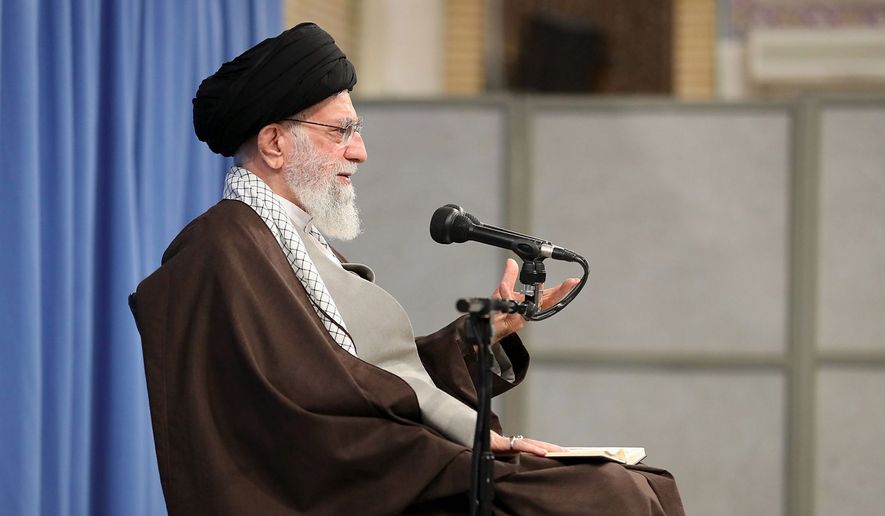A Defense Intelligence Agency report made public this week concludes that Iran’s government remains prepared to pursue nuclear weapons and missiles to deliver them.
ARTICLE BY BILL GERTZ | thewashintontimes.com

“Iran’s overarching strategic goals of enhancing its security, prestige, and regional influence have led it to pursue nuclear energy and the capability to build missile-deliverable nuclear weapons, if it chooses to do so,” says the report, “Iran Military Power.”
The report says Iran currently has no nuclear weapons and under the 2015 international nuclear deal agreed not to pursue nuclear arms. However, work by Tehran on space launcher vehicles indicates that Iran continues to develop long-range missiles that could be used for nuclear strikes.
While lacking intermediate-range and intercontinental-range missiles, “Tehran’s desire to have a strategic counter to the United States could drive it to develop and eventually field an ICBM,” the report said.
“Iran continues to develop space launch vehicles (SLVs) with increasing lift capacity — including boosters that could be capable of ICBM ranges and potentially reach the continental United States, if configured for that purpose,” the report said.
The 2015 nuclear agreement, known as the Joint Comprehensive Plan of Action (JCPOA), limits Iranian nuclear enrichment capabilities until 2026 and requires a redesign of a reactor at Arak. The limits will make it difficult for Iran to produce plutonium for weapons, the DIA said.
“Without a sufficient source of weapons-usable fissile material, Iran cannot produce a nuclear weapon,” the report said.
Iran initially planned to develop a warhead in the 1990s for its Shahab-3 missile but later gave up the program.
Iran was a recipient of warhead design information from the Pakistani nuclear supplier network headed by scientist A.Q. Khan. Documents from that network uncovered in Libya in 2003 included Chinese language instructions on how to make a nuclear warhead for a missile.
The United States pulled out of the nuclear pact in May 2018 and began reimposing economic sanctions on Iran.
Tehran initially announced it would continue to follow the limits while seeking to renegotiate the JCPOA.
“However, [Iranian Supreme Leader Ayatollah Ali] Khamenei warned that Iran would exit the deal if Iran were unable to achieve sufficient economic benefits from the JCPOA absent the United States,” the report said.
In May, Tehran announced that it would stop adhering to some JCPOA limits. Two months later, the International Atomic Energy Agency said Iran had exceeded limits under the agreement on the size of its low-enriched uranium stockpile. The agency also said Tehran exceeded the treaty limit on the level of enrichment.
On Monday, Secretary of State Mike Pompeo said Iran announced plans to resume uranium enrichment at a nuclear plant at Fordow.
As a result, the United States ended a waiver on sanctions related to Fordow. “The right amount of uranium enrichment for the world’s largest state sponsor of terror is zero,” Mr. Pompeo said.
Fordow was built as an underground bunker for secret uranium enrichment, and Teheran has no legitimate reason to resume enrichment work there, Mr. Pompeo said.
“Iran’s supreme leader is reverting to his tried-and-true method of using nuclear brinksmanship to extort the international community into accepting the regime’s destabilizing activity,” he said. “The United States rejects this approach completely and calls on all nations to do the same.”
The DIA survey also reported that Iran’s military, which includes 600,000 troops, is equipped with Western, Chinese and Soviet-era weapons along with some newer domestic arms.
“Iran acquired significant assistance from other countries, including North Korea and China, to establish domestic production capabilities for major weapons programs,” the report said.
China also has provided technical assistance to Iran for cyberdefenses, and Iran in 2005 joined the China-led Asia-Pacific Space Cooperation Organization as a means of acquiring access to space technology.
Iranian military forces are strong on ballistic missiles and coastal naval capabilities, along with proxy forces. But a key vulnerability remains a lack of modern technology and weapons.
CHINA UPS PRESSURE ON U.S.
China’s government is stepping up pressure on the Trump administration to reject sanctions legislation over its crackdown on pro-democracy protests in Hong Kong.
The Hong Kong Human Rights and Democracy Act passed the Senate by a voice vote Tuesday, and similar legislation was passed by the House earlier. The two versions of the bill will go to a House-Senate conference before legislation is sent to the White House for the president’s signature.
If signed into law, Secretary of State Mike Pompeo would be required to certify annually whether Hong Kong retains enough autonomy from China to warrant special trade status.
Losing that status would severely hamper Hong Kong’s position as a global financial center that has been used by China for currency conversion and for other economic benefits.
One of the bill’s sponsors, Sen. Marco Rubio, Florida Republican, praised the Senate action.
“Today, the U.S. Senate sent a clear message to Hong Kongers fighting for their long-cherished freedoms: We hear you, we continue to stand with you, and we will not stand idly by as Beijing undermines your autonomy,” Mr. Rubio said.
“The passage of this bill is an important step in holding accountable those Chinese and Hong Kong government officials responsible for Hong Kong’s eroding autonomy and human rights violations.”
Beijing reacted with unusually harsh rhetoric, an indication that limiting Hong Kong’s financial status is a serious worry.
“The act passed by the U.S. Senate remains blind on facts and Hong Kong people’s well-being,” said Foreign Ministry spokesman Geng Shuang, adding that the measure is part of an American “hidden political agenda.”
“We urge the U.S. to grasp the situation, stop its wrongdoing before it’s too late and immediately take measures to prevent this act from becoming law,” he said.
China will take unspecified “strong countermeasures” if the sanctions bill becomes law, Mr. Geng said.
NAVY LOSING MISSILE RACE
High-speed anti-ship missiles deployed by China and Russia threaten the Navy’s ability to defend warships from attack, according to a report by the U.S. Naval Institute.
“The U.S. Navy has fallen so far behind in this missile arms race it likely already has lost. It has no purpose-built supersonic anti-ship missile,” says Navy Lt. Cmdr. James Turnwall, a reservist, writing in the latest issue of the magazine Proceedings.
Cmdr. Turnwall said the lethality of anti-ship missiles has greatly exceeded Navy missile defenses and the Navy needs to develop revolutionary weapons technologies to leap over the Chinese and Russian competition.
“For too long, the Navy has promoted a defensive missile strategy, using Aegis cruisers and destroyers to protect a single, high-value target — the aircraft carrier,” Cmdr. Turnwall stated. “Against modern offensive missiles, this strategy no longer is sound.”
The problem is that enemy anti-ship missiles now have ranges greater than 200 nautical miles, with some exceeding 300 nautical miles, including missiles launched from aircraft. Surveillance and interception of those missiles is not possible with current carrier-based defenses.
Among the weapons now deployed are Russia’s SS-N-27 supersonic anti-ship missiles and China’s YJ-12 anti-ship missile, along with longer-range DF-21 anti-ship ballistic missiles.
The Chinese missiles cost far less to produce than similar U.S. SM-2, SM-3 and SM-6 air defense missiles, making warships vulnerable to saturation attacks that can overwhelm defenses.
China, for example, could overwhelm a U.S. aircraft carrier or guided missile destroyer with missiles in what Cmdr. Turnwall called a “shocking” low-cost kill ratio of anti-ship missiles to Navy defense missiles.
“At an estimated $1.5 million per unit, Chinese YJ-12s could saturate the warship’s defenses for less than $30 million,” he said.
One solution is to abandon making more advanced missiles and leverage advanced directed energy weapons such as lasers and rail guns, which are lower in cost than current Aegis warship missiles.
“This would enable the Navy to achieve strategic saturation in any battle space,” Cmdr. Turnwall wrote.

